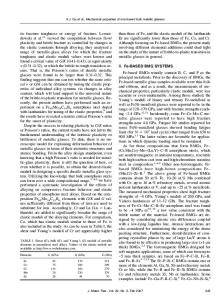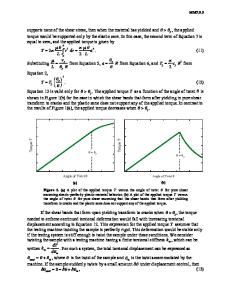Synthesis and mechanical characterisation of Fe-based bulk metallic glasses and mixed amorphous/crystalline phases
- PDF / 428,287 Bytes
- 6 Pages / 612 x 792 pts (letter) Page_size
- 13 Downloads / 324 Views
Q11.4.1
Synthesis and mechanical characterisation of Fe-based bulk metallic glasses and mixed amorphous/crystalline phases Alberto Castellero1, A. Lindsay Greer2, A. Reza Yavari3, Akihisa Inoue1 1
Institute for Materials Research, Tohoku University, 2-1-1 Katahira, Aoba-Ku Sendai, Miyagi 980-8577, Japan 2 Department of Materials Science and Metallurgy, University of Cambridge, Pembroke Street, Cambridge CB2 3QZ, United Kingdom 3 LTPCM-CNRS, Institut National Polytechnique de Grenoble, B.P. 75, 38402, St Martin d’Hères, France ABSTRACT Fully amorphous and mixed amorphous/crystalline bulky (Fe77+yGa3P9.5-yC4.5B3.5Si2.5)(100x)/100Fex alloys were prepared varying Fe and Fe-P contents. The effect of the compositional changes on glass forming ability (GFA), stability of the amorphous phase and mechanical properties was studied. When y = 0 and x is enhanced from 0 to 2, the stability of the supercooled liquid region decreases of 10 K. For x = 0 and y = 3.5 the glass forming ability is drastically reduced leading to a mixed structure consisting of bcc-Fe, Fe3(P,C,B) and a small fraction of amorphous phase. During compression test at room temperature the deformation of fully amorphous samples (y = 0) is dominated by the initiation and propagation of shear bands with consequent nil or small plastic deformation (0.2 % at 3000 MPa) for the alloys with x = 2 and x = 0 respectively. Embrittlement of (Fe77Ga3P9.5C4.5B3.5Si2.5)0.98Fe2 was observed after partial and full devitrification. A higher Young modulus and a maximum strength of 3300 MPa were shown by the as cast partially crystalline Fe80.5Ga3P6C4.5B3.5Si2.5 alloy; also in this case, no yielding was detected. Finally, compression tests at high temperature for fully amorphous Fe77Ga3P9.5C4.5B3.5Si2.5 showed inhomogeneous deformation up to 402ºC. Homogeneous nonNewtonian plastic deformation was detected at 427ºC. Newtonian homogeneous flow at 452ºC is limited by the crystallisation of the superliquid and consequent final failure. INTRODUCTION The present limit to structural applications of single amorphous phases is the limited yielding showed at room temperature because of the inhomogeneous plastic flow led by the initiation and propagation of shear bands [1]. Non-Newtonian and Newtonian superplastic flow can be detected in many families of bulk metallic glasses (e.g. Zr, Pd, La, Pt and Co based BMGs in Refs. [2,3], [4], [5], [6] and [7] respectively) when the deformation is carried above the glass transition temperature. Plastic deformation of BMGs at room temperature can be successfully improved by dispersion of a crystalline phase, showing an intimate interface with the amorphous matrix, as reported in Ref. [8] for the case of Zr-based systems. The authors also underlined the important role played by the grain size and volume distribution of the reinforcing particles in the vitreous matrix, in order to disrupt the propagation of the shear bands.
Q11.4.2
In the case of a mixed microstructure (i.e. amorphous + fcc-Fe) obtained by solidification of a melt with poor GFA,
Data Loading...











